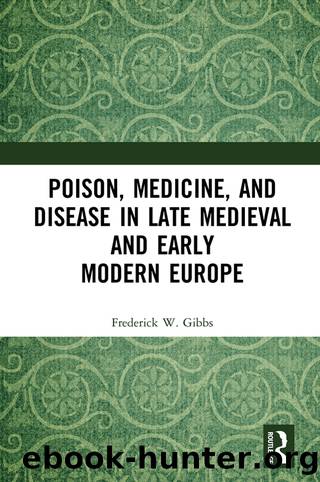Poison, Medicine, and Disease in Late Medieval and Early Modern Europe by Gibbs Frederick W.;

Author:Gibbs, Frederick W.;
Language: eng
Format: epub
Publisher: Taylor & Francis Group
Occult definitions and forms
As previous chapters have demonstrated, late thirteenth and fourteenth physicians such as Jean de Saint-Amand, Arnau of Villanova, and Bernard of Gordon elaborated on (and helped disseminate) Avicenna's discussion about poison in the Canon, which emphasized the notion of specific form (or total substance) as a feature of venenum that could set it apart from other materia medica. Many mid-fourteenth-century authors of plague tracts, such as Gentile da Foligno, relied on the notion of poison and its specific form to describe the virulent action of pestilential disease. Later fourteenth-century poison texts, such as those by Guglielmo de Marra and Cristoforo de Honestis, show how the notion of specific form had become perhaps the principal feature that distinguished poison from medicine. However, although these physicians distinguished between medicines and poisons, they only scratched the surface of the implications of this distinction, such as the properties of poison itself, or the properties of a poisoned body. Furthermore, while it has been suggested that specific form had become a defining feature of poison, fifteenth-century medical texts complicate that interpretation, suggesting that even as some authors found it quintessential, others conceptualized specific form principally within complexional terms.6 Specific form aside, the tone and argumentation of fifteenth-century treatises suggest the myriad challenges that poison presented to physicians interested in the nature of venenum, including reconciling the plurality of definitions and descriptions offered by previous medical authorities.
To highlight the tension between the importance of specific form in understanding the nature of poison on the one hand, and its uncertain place in understanding the long history of poison on the other hand, we begin with definitions of poison offered by two Italian physicians who flourished in the first half of the fifteenth century and became preeminent authorities on poison, Antonio Guaineri and Sante Arduino. Guaineri studied at the University of Padua under Biagio Pelacani da Parma and Iacopo da Forlì, and was made physician of the Duke of Savoy in 1427; he died, probably in Pavia, likely soon after 1448.7 Guaineri examined the nature of poison through a decidedly philosophical (some might say scholastic) approach in his dual tract on pestilence and poison composed sometime around 1440.8 Guaineri organized his treatise on poison into twelve chapters, most with two parts: the first part summarized the positions of the authorities on a particular topic; the second presented some questions (dubia) about them and responded. It has been remarked that Guaineri generally did not excel in scholastic debates and avoided them systematically;9 however, on the topic of poison Guaineri tackled numerous theoretical problems and freely disagreed with earlier medical authorities, such as Avicenna, Pietro d 'Abano, and Cristoforo de Honestis.
One of the key features of Guaineri's text is the way in which Guaineri offered more systematic and terminologically rigorous descriptions of poison and its propertiesâacross a wide range of natural philosophical questionsâthan did earlier physicians. Contrary to earlier authors of poison texts, he relied heavily and explicitly upon his own experience as a physician. However, given
Download
This site does not store any files on its server. We only index and link to content provided by other sites. Please contact the content providers to delete copyright contents if any and email us, we'll remove relevant links or contents immediately.
| Africa | Americas |
| Arctic & Antarctica | Asia |
| Australia & Oceania | Europe |
| Middle East | Russia |
| United States | World |
| Ancient Civilizations | Military |
| Historical Study & Educational Resources |
Magic and Divination in Early Islam by Emilie Savage-Smith;(1463)
Ambition and Desire: The Dangerous Life of Josephine Bonaparte by Kate Williams(1286)
Bohemians, Bootleggers, Flappers, and Swells: The Best of Early Vanity Fair by Bohemians Bootleggers Flappers & Swells- The Best of Early Vanity Fair (epub)(1265)
Papillon by Henry Charrière(1265)
Twelve Caesars by Mary Beard(1148)
Operation Vengeance: The Astonishing Aerial Ambush That Changed World War II by Dan Hampton(1113)
What Really Happened: The Death of Hitler by Robert J. Hutchinson(1076)
London in the Twentieth Century by Jerry White(1054)
Time of the Magicians by Wolfram Eilenberger(1031)
Twilight of the Gods by Ian W. Toll(1027)
The Japanese by Christopher Harding(1025)
Lenin: A Biography by Robert Service(986)
The Devil You Know by Charles M. Blow(936)
Freemasons for Dummies by Hodapp Christopher;(892)
A Social History of the Media by Peter Burke & Peter Burke(885)
Napolean Hill Collection by Napoleon Hill(861)
The Churchill Complex by Ian Buruma(860)
The Rise and Triumph of the Modern Self by Unknown(856)
Henry III by David Carpenter;(855)
